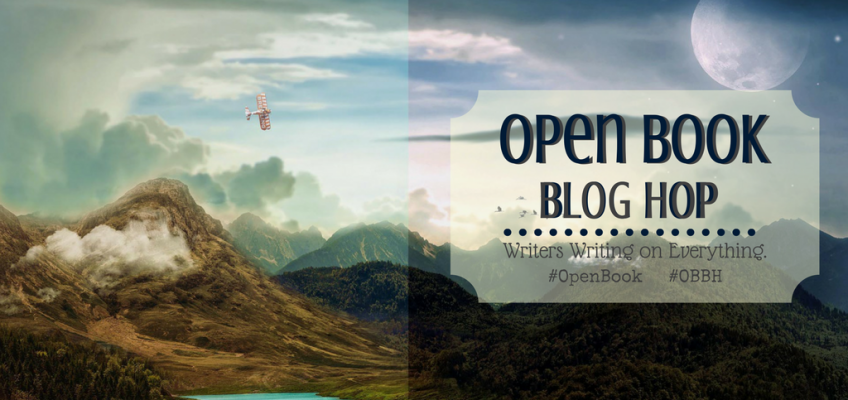Welcome back to another blog hop, with #OpenBook. Here’s this week’s prompt.
Let’s talk about book descriptions. Do you write yours before or after you write the story?
I’d rather we didn’t mention book descriptions. They are the bane of my life, a necessary evil that nobody mentioned in the brochure. Hatred may be too strong a word, fear and dread come pretty close.
The way I work, I get the whole story in linear order. I have no idea what will happen after the first scene has popped into my head. As I write, I find myself heading off on the same journey of discovery as the reader will take. I don’t have a clue about the plot, who else may appear and who will still be upright and/or breathing at the end. Even the setting is not fixed, now or then or somewhere in between. It could be halfway across the galaxy or just around the corner.
We’ll get to that when we need to.
Once I’ve finished the story (and that’s not always as obvious as you might think), I have to go over it and pick out the important bits to form the description.
I find it quite hard to condense 80000 words into 150. I guess that I’m not alone in that. However, my plotting friends surely have an easier job, not least because they already knew what was going to happen.
I have tried picking what I think are the important things out as I go but that disrupts my flow and very often, they become less relevant as the journey progresses.
Probably for that reason, I don’t think that my descriptions are very good, at least not the first versions, there seems to be as much work involved in getting something small as there is in getting the main bulk.
I think (and this will sound really weird), that whoever is giving me this information isn’t bothered with the short version. He/She/They couldn’t care less. Hence, I have to write it myself. Because I’m not a writer, just a conduit, I find it hard to actually do something creative on my own.
My descriptions change and evolve many times. If you look at one of my early paperbacks, the blurb on the back will bear no resemblance to that on the current product page on Amazon. Or Audible in the case of my audiobooks. Another job for my P.A. (when I become rich and famous), will be to restore all the continuity across editions.
The problem is, it doesn’t matter how many people you ask, you will find it hard to get a consensus on the suitability of what you have produced. The last time I asked, I got the exact same number of people telling me it was good as those who said it needed work.
You only really know whether that version floats that particular reader’s boat. Not which one will float more boats than others.
You just have to try it and see what happens. The great thing is that you can change a description and have it uploaded in minutes.
Which means that you can practice to your heart’s content. I haven’t found that it makes the job any easier though.

Let me know what you think about this week’s subject.
I’d love to get your comments, please leave them below. While you’re here, why not take a look around? There are some freebies and lots more content, about me, my writing and everything else that I do. You can join my newsletter for a free novella and more news by clicking this link.
Now see what the other blogs in this hop have to say by clicking below.
Check out the other great blogs here.
I’d love to get your comments, please leave them below. While you’re here, why not take a look around? There are some freebies and lots more content, about me, my writing and everything else that I do. You can join my newsletter for a free novella and more news by clicking this link.
![]()



Chris L Adams
I feel your pain, Richard. The dreaded synopsis. The obligatory blurb. I have documents full of them for each story where I’ve revised them so many times. Really, we should probably take the approach of movie/TV show blurbs on Netflix, Amazon, & Etc.
Here’s the synopsis to Arctic, starring Mads Mikkelsen, a favorite movie of mine, as taken from Amazon Prime:
“A man stranded in the Arctic after an airplane crash must decide whether to remain in the relative safety of his makeshift camp or to embark on a deadly trek through the unknown in hopes of making it out alive.”
Now, that doesn’t dive into what he was doing when he wrecked, or what caused the wreck; it doesn’t mention the tactics he’s taken to survive, like ice fishing, or his encounters with Polar bears. It doesn’t mention the other main character in the movie, the girl he is trying to save, who probably gives him the impetus to leave the safety of his fuselage and venture across a wild, Arctic, snowy, death-trap riddled landscape to reach a place of safety. It doesn’t speak of his daily routine of winding up his wireless set and scanning for radio frequencies, or falling into ice caves, or having bears break into his store of fish and devour days and weeks of fishing, cached to help him survive in sub-zero temperatures. See how much longer this summary is than that which they chose to go with on Prime? Gads, I think I need to take my own advice and think up some one-sentence summaries for all of my novels pronto.
Richard Dee
Thanks, Chris. That’s a great example. It’s a tricky balance, how much do you say? I’ve been told that the SAME blurb is too long and involved and also that it’s too short and sparse. As I said, it’s so subjective, trying to find the one that pleases the most people.